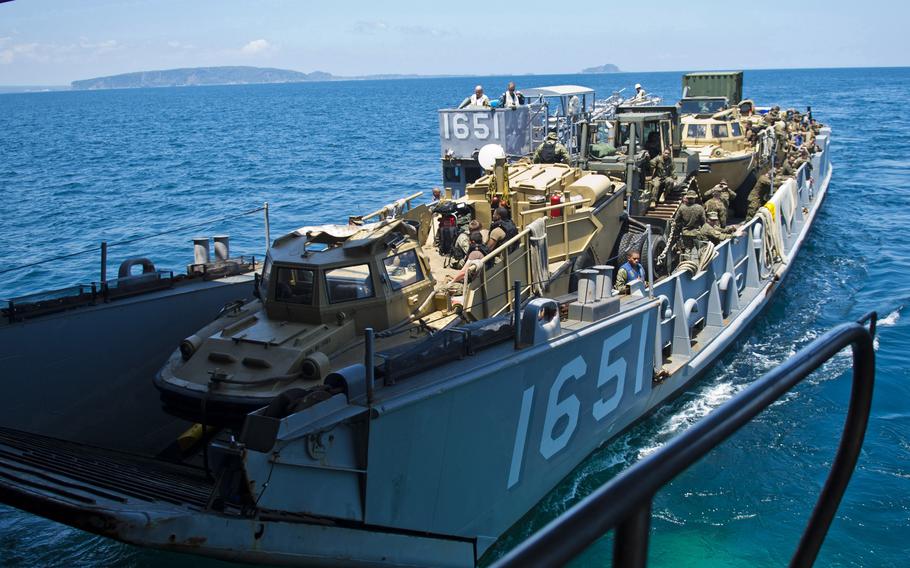
A landing craft exits the well deck of the amphibious dock landing ship USS Tortuga in 2013. The Tortuga is one of three amphibious ships being retired next year by the Navy. (U.S. Navy)
WASHINGTON — Navy Secretary Carlos Del Toro clashed with senators Tuesday over plans to retire several amphibious warships and not replace them, which would result in the service having fewer of the ships than is required by federal law.
“This is a big issue, and right now the secretary of the Navy ignoring the Congress of the United States is unacceptable,” Sen. Dan Sullivan, R-Alaska, said of the Navy’s shipbuilding plans and recent decisions made by Del Toro.
The service’s $255 billion budget request for fiscal 2024, released last month, proposes to decommission several amphibious warfare ships — but it includes no funding for vessels to replace them. The Navy’s 30-year shipbuilding plan states the service is doing a cost and capability study on amphibious ships, and that should determine when replacements will be built.
The Navy must have “not less than 31 operational amphibious warfare ships” to be at full strength, according to the 2023 National Defense Authorization Act, which sets annual spending priorities for the Pentagon. Amphibious warfare ships include dock landing vessels and assault ships that can swiftly deliver Marines and equipment on land during an assault from the sea. The Navy meets the requirement now, but it won’t if it succeeds in retiring three of the ships next year.
“We are requesting the divestment of USS Germantown, USS Gunston Hall and USS Tortuga, three amphibious ships that are all at or over 34 years of service and in unsatisfactory material condition,” Del Toro said at Tuesday’s hearing. “We recognize this request brings us below the 31 amphibious ships we are required to maintain. [We] are committed to ensuring we meet this requirement and doing so in a timely manner but with a capable, sustainable mix of ship classes that will support our Marines and sailors for decades to come.”
Last year, Del Toro ordered a strategic pause on new amphibious warships so the cost and capability study could be completed. The move is part of the Navy’s efforts to recalibrate and modernize its capabilities. The 30-year shipbuilding plan includes no San Antonio-class amphibious ships, which were originally intended to replace Whidbey Island-class vessels such as the soon-to-be-retired Germantown, Gunston Hall and Tortuga.
Sen. Roger Wicker of Mississippi, the top Republican on the committee, said that he’s concerned about retiring amphibious ships with no replacements and called the Navy’s budget request “anemic.” He slammed the Navy leaders and said they have “failed yet again to build a Navy fleet that’s capable of … growing strong enough to deter near-term threats.”
Later, Sullivan expressed agitation for Del Toro’s decision to pause construction of amphibious ships and put the fleet on a path in the coming years to fall below the congressional minimum.
“We told you what to do, and you need to do it,” Sullivan said. “You’re violating the law right now, and your shipbuilding plan looks to say, ‘Hey, we’re going to violate the law for the next 30 years.’ ”
“It is my intent to follow the law,” Del Toro answered. “Hopefully by the time of the president’s [2025] budget submission … I will look at that as an option.”
“It’s not an option for you, Mr. Secretary,” Sullivan shot back. “You are ignoring us. Worse, you’re ignoring the law.”
Gen. David Berger, the Marine Corps commandant, said he’s concerned about readiness if the Navy doesn’t have at least 31 amphibious ships.
“If something happened in Taiwan … time matters,” he said. “Most of the cases, you need a seaborne force. And you need Marines that can project power ashore.”
Berger said the amphibious ships are important because they’re also a sign of commitment to U.S. allies around the world, and a signal of strength to potential adversaries such as China and Russia.
“When the prime minister and minister of defense for Sweden wanted to send a clear signal to Russia regarding Sweden’s intention to join NATO, they did so by making a statement on the flight deck of the USS Kearsarge — a Wasp-class amphibious assault ship,” Berger said.
Del Toro and Berger met later Tuesday with the Senate committee in closed session to share classified information. At one point during the open hearing, Sullivan demanded Del Toro come back to the Senate soon with an answer on “how you’re going to fix this.”
The Navy’s cost and capability study on amphibious ships is expected to be released in June, the Navy said.